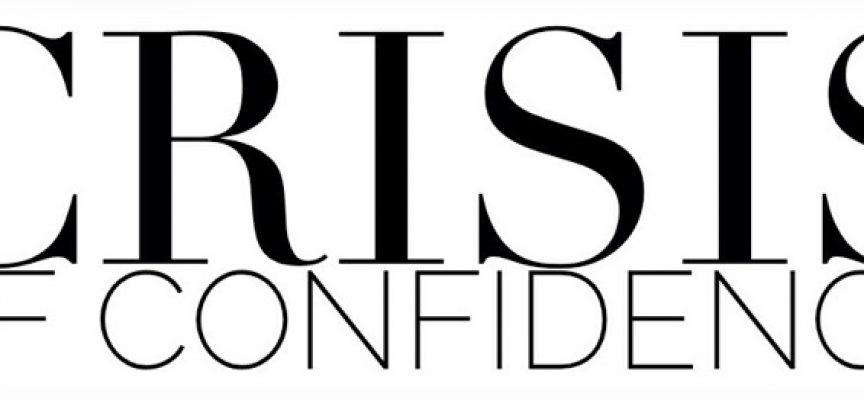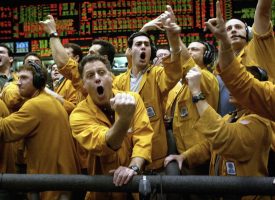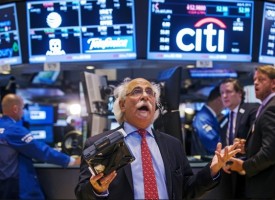With the gold market getting hit as the dollar rallies after the VIX saw its lowest print in almost a quarter century, is the world headed for another financial crisis?
May 9 (King World News) – Here is what Peter Boockvar wrote today as the world awaits the next round of monetary madness: With the lowest VIX closing print since December 28th, 1993 yesterday and it being discussed everywhere I’ll chime in as a watcher of it for the past 25 years when over the course of that time it averaged 20. The VIX we know tells us nothing about where markets go in the short term as it’s just another short term indicator on the scoreboard but at the same time it’s easy to say that from this level the next 5-10+ points are up, not down with just the question being when and how much the stock market falls in that move (assuming it does). About 3 ½ months after that 1993 print it spiked to 24 and the SPX fell about 7% as the Greenspan Fed began what was to be an aggressive rate hike cycle…
IMPORTANT:
To find out which company the richest man in China has invested in, one that
Rick Rule and Sprott Asset Management are pounding the table on that
is quickly being recognized as one of the greatest investment
opportunities in the world – CLICK HERE OR BELOW:
The Height Of Complacency
It revisited the low 10 level in late 1995 and the SPX fell 3% right after but then took off as we know the spectacular part of the 1982-2000 bull market was just beginning. We again saw the 10 level in 2005 but the market still had time to go on the upside even though Greenspan was hiking rates at every single meeting that year. The true delusion started to set into stocks when in late 2006 into early 2007 the VIX broke even below the 2005 low just as the credit markets were beginning to blow up. That was the height of complacency that was quickly shattered by late February ’07. Bear Stearns closed at a record high of $171.51 on January 12, 2007. By June of that year, the two internal mortgage based hedge funds imploded and Bear fell to around $150. I won’t rehash anymore.
So what’s the outlook now? If you believe that more rate hikes and quantitative tightening from the Fed, a form of it from the ECB as they taper, and tighter liquidity and forced deleveraging in China is no big deal, then don’t worry about a low VIX. If you believe as I do that it is a really big deal then understand that when the VIX historically has broken 10, it has rarely stayed this low for very long.
The April NFIB small business optimism fell a hair to 104.5 from 104.7 in March. It is at the lowest level since it printed 98.4 in November but is still near the best level since 2004. Many of the key internals weren’t that much changed either but we did see a sharp move in the Expectations component. Plans to Hire held at 16%. Those planning Increased Capital Spending fell 2 pts to 27% after rising by 3 pts in March. Those that Expect a Better Economy fell 8 pts to the lowest since November but is still well above the 12 print that month. Those that Expect Higher Sales rose 2 pts to 20% but after falling by 8 in March. It printed 11% in November. Reflecting the tight labor market, Positions Not Able to Fill rose 3 pts to the most since November 2000. That was not reflected in the compensation plans as they were flat to down but are we on the cusp of an acceleration? We think so. The key inflation component, those expecting Higher Selling Prices, rose 2 pts to the most since 2014. Those that said it’s a Good Time to Expand was up 2 pts while Earnings Trends were unchanged at a still -9%.
The NFIB is saying that this April read didn’t reflect the House passage of their healthcare bill and instead reflected the first failed attempt. “Whether expectations for better business conditions will recover in the May Optimism index remains to be seen” and the CEO of the NFIB said “The drop in expected business conditions should be a warning to Washington that health care reform, regulatory reform, and tax reform have implications far bigger than politics.” The NFIB “noted that taxes jumped to the top of the list of concerns among small business owners in the April survey.” This number is never market moving but is a good anecdotal tell on this key sector of the US economy and their sensitivity to government policy that most certainly is changing.
 The Path To Full Debt Monetization
The Path To Full Debt Monetization
The realization of higher wages in Japan failed again in March and in fact went backwards. Regular pay fell .1% y/o/y, the first decline since May 2016. The headline number was worse because of a deeper drop in overtime pay and bonus’. It is this pathetic pace of wage growth in the face of a labor market that is extremely tight that makes Kuroda and the BoJ’s desire for higher consumer prices absolute nonsense. They are essentially hoping that CPI gets to 2% but if wages accelerate by the same amount, the Japanese citizenry are no better off than they are today. That said, if inflating out of a debt bubble is the true goal, that’s a different discussion. Moody’s today said “the BoJ is emerging as the main source of highly affordable funding for the government of Japan. Structural factors weighing on net savings rates will constrain the private sector’s capacity to fund new government debt in the future.” They are on the path to full debt monetization. The Nikkei was down by .25% while the yen is lower to the weakest level since mid March. The performance in the US dollar is becoming more and more bifurcated. You can’t just say now it’s going up or down in the absolute because its behavior against many of the major currencies is more and more mixed. JGB yields closed higher and followed the rise in yields in Europe and the US.
Sovereign Bond Markets Are Still A Tinderbox
As I stated yesterday that eyes should shift again to Mario Draghi and the ECB after Macron’s victory, the German 2 yr note yield is trading at the least negative level since late January. The German 10 yr yield is at a 7 week high. I’ve been a vocal bear on European sovereign bonds and I need to remind all that the German 10 yr yield touched 6 bps on May 20th 2015 and was 72 bps one month later and closed at 98 bps just one month after that. My point is that the sovereign bond markets are still a tinder box of problems depending on what central banks do from here and risk happens fast. Stay focused too on Italian yields as they are up by 3 bps to 2.28%, just 10 bps from the highest in 2 years. The US 10 yr yield is quietly at a 4 ½ week high.
***KWN has now released the remarkable audio interview with London whistleblower Andrew Maguire and you can listen to it by CLICKING HERE OR ON THE IMAGE BELOW.
***ALSO JUST RELEASED: This Will Signal The Gold Market Has Reversed Higher CLICK HERE.
© 2017 by King World News®. All Rights Reserved. This material may not be published, broadcast, rewritten, or redistributed. However, linking directly to the articles is permitted and encouraged.









